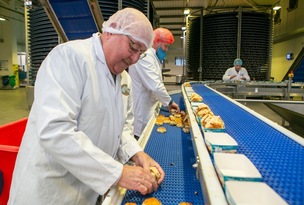A PROBE into children’s bulging waistlines has revealed one in five reception-age pupils are now classed as obese in Barnsley - and the figure grows to almost one in three by the time they leave primary school.
The study, which focuses on the South Area Council’s wards including Rockingham, Hoyland Milton, Wombwell and Darfield, says 20.3 per cent of its four and five-year-olds are obese, higher than Barnsley’s overall rate of 18 per cent.
However, rates for ten and 11-year-olds rockets to 32.4 per cent in the South and 32.1 per cent across the borough - which the report says is an ‘all-time high’ - but remains slightly lower than 34.3 per cent national average.
Compiled by public health bosses in the town, it reveals Barnsley as a whole is the fourth-worst area in Yorkshire and the Humber for physical activity and for the proportion of residents who eat five portions of fruit and vegetables per day.
It said: “Severe obesity in ten to 11-year-olds has now reached an all-time high. Overweight children are more likely to be obese as adults, increasing their risk of heart disease and some cancers.
“More young people than ever are developing type two diabetes. Excess sugar can also lead to painful tooth decay, bullying and low self-esteem in childhood.”
The Rockingham ward is the worst-hit area according to the study, with a quarter of its four to five-year-olds obese, while Hoyland has 24.7 per cent, Wombwell has 17.7 per cent and Darfield fares better with a rate of 14.2 per cent.
However, the figures for ten to 11-year-olds, which is the age when a child leaves primary school, grow rapidly in each ward and although Hoyland has the highest rate of 34.5 per cent, Darfield’s children’s figures more than doubled to 30.4 per cent in that five-year period from reception to joining high school.
Dr Alison Tedstone, chief nutritionist for Public Health England, said: “Children are consuming too much sugar, but parents can take action now to prevent this building up over the years.
“With a third of children leaving primary school overweight, tackling obesity requires wider action and is not just limited to individual efforts from parents.
“We are working with the food industry to remove 20 per cent of sugar from the products contributing the most to children’s sugar intakes by next year.
“I encourage all Barnsley parents and carers to take a look at some of the easy ways they can help their children consume less sugar and teach them how to make healthier choices that stay with them for life.”
The South area also has the highest prevalence of diabetes in Barnsley, with 70 per cent having high blood pressure and excess cholesterol.
A total of 4,560 South residents are at risk of a heart attack or stroke who are not aware they have high blood pressure and more than 100 people who are diagnosed but who are not getting the right treatment to minimise the risk.
Excess weight was identified as one of the public health bosses’ strategic priorities between 2018 and 2021 and Barnsley Council’s ‘food plan’ is a ‘response to the increasing levels of obesity in the borough’.
Coun Jim Andrews, cabinet spokesperson for public health, said: “The proportion of Barnsley children who carry excess weight in reception is lower than the England rate, however the rate for ten to 11-year-olds is slightly worse than the rate, but not significantly.
“Compared to the other South Yorkshire authorities, Barnsley has the highest rate of four to five-year-old children who are a healthy weight.
“Barnsley Council’s food plan is about changing the food environment and culture within the town as well as improving access to quality food.
“Our approach focuses on developments to the policies and structures which we live, work, shop, eat and learn within, focusing on the social, cultural and environmental conditions around us.”




























